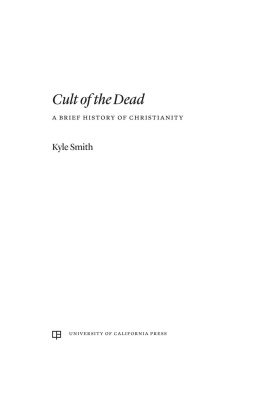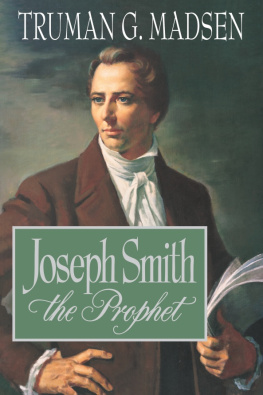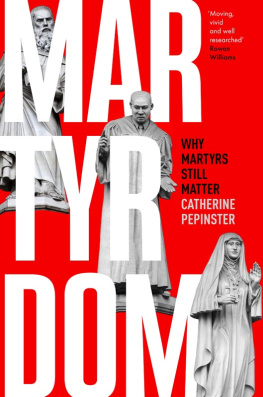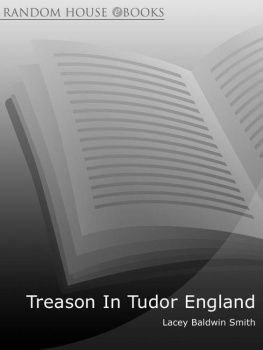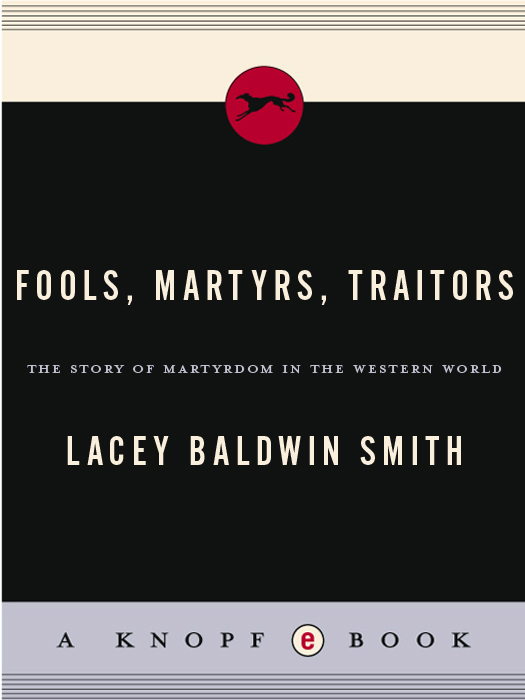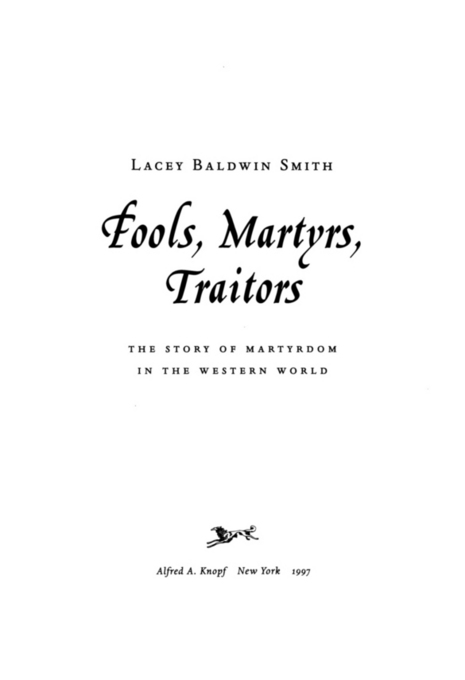ALSO BY LACEY BALDWIN SMITH
Treason in Tudor England:
Politics and Paranoia
The Past Speaks:
Sources and Problems in English History to 1688
(with Jean R. Smith)
Elizabeth I:
Problems in Civilization
Dimensions of the Holocaust, ed.
Elizabeth Tudor:
Portrait of a Queen
Henry VIII:
The Mask of Royalty
World History in Outline
(with Jean R. Smith)
(new edition entitled Essentials of World History)
The Elizabethan World
(published in England as The Elizabethan Epic)
This Realm of England, 13991689
A Tudor Tragedy:
The Life and Times of Catherine Howard
Tudor Prelates and Politics
THIS IS A BORZOI BOOK PUBLISHED BY ALFRED A. KNOPF, INC .
Copyright 1997 by Lacey Baldwin Smith
All rights reserved under International and Pan-American Copyright Conventions. Published in the United States by Alfred A. Knopf, Inc., New York, and simultaneously in Canada by Random House of Canada Limited, Toronto. Distributed by Random House, Inc., New York.
http://www.randomhouse.com/
Owing to limitations of space, all permissions to reprint previously published material may be found immediately following the index.
Library of Congress Cataloging-in-Publication Data
Smith, Lacey Baldwin.
Fools, martyrs, traitors : the story of martyrdom in the Western world / by Lacey Baldwin Smith.
p. cm.
eISBN: 978-0-307-81746-4
1. MartyrdomHistory. 2. MartyrsBiography. 3. TraitorsBiography. I. Title.
BL626.5.S65 1997
179.7dc20 96-38582
v3.1
To my wife and our three adult offspring,
especially Katherine Chandler,
who helped to bring her mother
into the computer age
CONTENTS
ACKNOWLEDGMENTS
Fools, Martyrs, Traitors owes its existence to the encouragement and tolerance of my colleagues, students, and, of course, to she who is always obeyed, my wife, Jean. Robert Lerner read an experimental version of the first chapter and wisely warned me not to give too much away in an introduction; Gary Wills lent his expertise on Socrates; Bill Heyck and Richard Kieckheffer prevented me from treading on too many tender toes in the chapter on Jesus; Jack McLean tactfully cleansed my ethnocentric misconceptions when handling Gandhi; and Peter Hayes guided me into the labyrinth of German history, the Holocaust, and the careers of Dietrich Bonhoeffer and Kurt Gerstein. Lerner, a New Yorker, who remembered his parents talking about Julius and Ethel Rosenberg, did extra duty by reading the section on the Rosenbergs. I am profoundly grateful to all six for their support.
The idea for this book actually began some fifteen years ago as an undergraduate history seminar on martyrs which became affectionately known by students as Finks, Stinks, and Weirdos. The aim of the course was to excite students about history and expose them to the historical process. Whatever my pedagogical achievements may have been, one accomplishment is indisputable. I, if not my Northwestern students, became fascinated by the subject, and I decided to study and write about the concept of martyrdom, thereby refuting the oft-assumed conflict between teaching and research.
CHAPTER 1
T HE D EBATE OVER D EFINITION
Martyrs, cher ami, must choose between being forgotten, mocked, or made use of. As for being understoodnever!
A LBERT C AMUS ,
The Fall
N OT EVEN God, it is said, can change history, but the historian can; his profession requires him to do so. The process entails not so much the deliberate distortion or misrepresentation of the factsthat would be a violation of the rules of the gameas the placement of events in a continuum, giving to human action and thought a past and a future, and creating for history a family of ancestral causes and descendant effects. The past is filled with a host of parentless actors and actions, but of all of historys orphans possibly the martyr is the most lonely and isolated, appearing to us, like both the hero and the traitor, as a two-dimensional stereotype. We find it jarring to imagine the pusillanimous hero, the specious martyr, or the open-hearted traitor. By definition the hero is cleft-chinned and stalwart, the martyr serene-faced and compassionate, and the traitor evil-eyed and conniving. But place martyrs within an historical sequence, relate them to their close cousins the fool and the traitor, assign them siblings and descendants, and ask what personal and cultural interests motivated their sacrifices, and they become complex personalities subject to analysis and criticism. For if a single truism can be claimed for martyrdom, it is that their lot is not an easy one.
Death itself is rarely the stumbling point. The martyr belongs to that select association of men and women who are in such absolute control of their own existence, knowing its exact value, that they are willing to abandon it, flinging life away as if it were no more important than last months The trick is to transform death from a conclusion into a beginning, to make it count; but to do so places the martyr in a peculiarly exposed position. So much depends on the debate over definition, the judgment of history, the cooperation of the executioners, the vagaries of timing and circumstance, and the question of motive.
Who, then, qualifies as a proper martyr? Does the distinction between the fool, the martyr, and the traitor rest solely in the eyes of the beholder? Are all martyrs heroes and all dead heroes martyrs? The term is hopelessly overworked and abused, and the moment the label moves beyond those martyrs carefully scrutinized and calendared by the Catholic Church the word becomes all things to all peoplethe universal good guy. The martyr suffers, like the hero, from celebrity hype and political expediency,
If society has been lavish in bestowing the martyrs crown, it has been even more confused and quarrelsome about the validity of the title. What is the distinction between a victim and a martyr? Should we confer the honor of martyrdom upon the millions who died in the Nazi holocaust, or were they just unlucky and choiceless people caught in an ideological maelstrom? What of the soldier-hero dead upon the battlefield? Is he a martyr to his country, or is death simply an occupational hazard, a calculated risk for all military personnel? What are we to think of the young man in California who lay down on a railroad track in front of an approaching train to display his passionate opposition to the construction and operation of a nuclear power plant? Trains supplying the plant had always stopped before, but this one didnt, and he lost both legs. Was he any more or less a martyr than the soldier who risks life but in his heart does not expect to die? Or was he just a damn fool? Were those kamikaze pilots of World War II, who flew suicide missions in defense of an emperor who claimed descent from the gods, martyrs or culturally conditioned automatons and overly advertised examples of a society that rated face, reputation, and national honor above life itself?
More disturbing yet, do those Arab terroristsoften only young boys and girlswho in the 1980s drove fire trucks at French and American installations in Lebanon qualify as martyrs, willing sacrifices to Allah, who have earned a guaranteed place in Paradise? Or, as the Western world much prefers, should they be viewed simply as drug-induced sacrificial pawns in a vicious game of power politics? How is society to categorize Dr. Baruch Goldstein, who one Friday morning in February of 1994 fired a hundred and eleven rounds from an automatic rifle into hundreds of Palestinian Moslems kneeling in prayer, killing forty worshipers? Goldstein died a victim of the anger, frustration, and hatred that consumed him, beaten to death by the survivors. Was he a martyr, a terrorist, or a madman? Is he any worse or better than John Brown, who in a series of Sorelian acts of violence and human slaughter deliberately sought to goad the Satanic South into open conflict so it could be destroyed by the North, the ordained instrument of Gods ultimate purpose?




